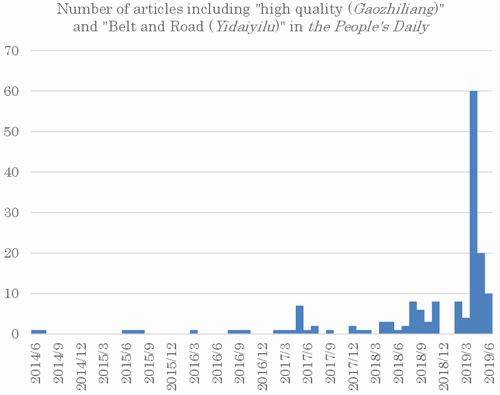- The Chinese government has begun to call for a "high-quality Belt and Road Initiative".
- At the same time, more multifaceted issues and softer approaches have become apparent.
- It is hoped that the Chinese government will be more pro-active in releasing relevant data.
The Belt and Road Initiative has now been underway for six years, and transformations are being considered in three regards: (1) a greater emphasis on sustainability and quality, (2) a more multifaceted scope, and (3) an increased focus on soft elements.
The first direction for transformation in the Belt and Road Initiative is a greater emphasis on sustainability and quality, topics that China itself has plainly begun to mention. For example, the keyword "high quality" did not appear even once in Xi Jinping's keynote address at the first Belt and Road Forum for International Cooperation held in May 2017, but it was brought up six times in his April 2019 keynote address. In April 2019, China's Ministry of Finance announced the "Debt Sustainability Framework for Participating Countries of the Belt and Road Initiative".
The second direction for transformation in the Belt and Road Initiative is a more multifaceted scope. This has manifested itself in the more widespread use of certain relevant references, among them being the laying of optic cables, the sharing of satellite information, a "Digital Belt and Road" inclusive of data distribution, a "Silk Road on Ice" linked to China's foreign policy on the Arctic, and the "Action Plan for Harmonization of Standards Along the Belt and Road (2018 - 2020)" that seeks to formulate international standards for 13 industrial sectors.
The third change is the emphasis on softer elements. The emphasis at the Conference on Dialogue of Asian Civilizations held in Beijing in May 2019 was not on infrastructure and economic cooperation but rather on softer international cooperation in the forms of think-tank exchanges and cultural contacts.
These three transformations are occurring because the Chinese government is confronting economic, political and international circumstances vastly different from those of 2012 when the Belt and Road Initiative was conceived. Perhaps the most conspicuous environmental change has been US-China trade frictions. Accusations that the Belt and Road Initiative creates debt traps have clearly led to China's emphasis on a "high-quality Belt and Road Initiative". Chinese officials began in 2018 emphasizing a "high-quality Belt and Road Initiative", which suddenly became a keyword at the second Belt and Road Forum for International Cooperation in 2019. On the one hand, a more transparent project management structure could limit the potential for funding that China has been freely providing. On the other, such a structure is seen as necessary for China itself from the perspective of managing funds. Connectivity improvements via infrastructure that were the initial priority of the Belt and Road Initiative continue to occupy an essential place but here, too, the preconditions have changed. In 2012, just prior to the announcement of the Belt and Road Initiative, much attention was being focused in China on the "two surpluses" of foreign reserves and steel production. In 2019, however, China is now under pressure from capital outflows, and the overcapacity in steel production continues to subside.

Source: Compiled from People's Daily database
Are Japanese companies and the Japanese government able to cope with these transformations in the Belt and Road Initiative? Conditional cooperation through third-market cooperation with Chinese companies is being pursued through projects within the Belt and Road Initiative that are relatively transparent and sustainable. Enjoying comparative advantages that differ from those of their Chinese counterparts, Japanese companies see potential for joint market development in third countries. In addition to Japanese and Chinese firms jointly engaged in plant construction projects already begun, financial and content companies are included among those participating in the 52 projects that have been announced. Attention will be focused on the results forthcoming in these new sectors. More important for Japanese companies than gaining practical benefits from cooperation abroad will be the more stable business environment for Japanese companies operating in China that firmer Japan-China relations will bring.
At the same time, the Japanese government is promoting several multilateral frameworks — the TPP11, the Japan-EU EPA, and the Free and Open Indo-Pacific Initiative — and it is actively helping create rules for e-commerce at the WTO. In a broad sense, these could be said to be efforts that address the increasingly multifaceted nature of the Belt and Road Initiative.
Should the Belt and Road Initiative successfully complete the aforementioned transformations, a high-quality, comprehensive and softer Belt and Road Initiative will emerge. The actual changes will likely not be as simplistic as described here. Even so, the fact that the world's second largest economic power is making adjustments to its flagship initiative is quite obvious, and a close eye should be kept on developments.
Only limited data is currently available on China's investment and aid, hindering understanding of the Belt and Road Initiative. There are quite a few private-sector companies in China seeking straight commercial ventures overseas. As the relevant data becomes more transparent, it will become possible to discuss the quality of the Initiative more frankly. Even if it may be difficult for China to accede to the OECD DAC, the Chinese government needs to be more pro-active in disclosing data on aid and investment connected with the Belt and Road Initiative to enable fair and transparent discussions and assessments.
Asei Ito is Associate Professor at The University of Tokyo.
The views expressed in this piece are the author's own and should not be attributed to The Association of Japanese Institutes of Strategic Studies.


